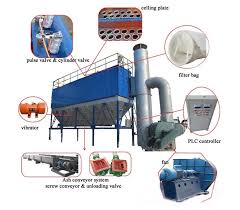TECHNOLOGY
Baghouse Collectors Explained: A Complete Guide to Efficient Dust Collection Systems

In many industries, managing air quality is essential for safety and productivity. Dust and other airborne particles created during manufacturing can pose serious health and environmental risks. This is where baghouse collectors come into play. These systems are specifically designed to remove dust particles from the air, creating a cleaner and safer work environment.
A baghouse dust collection system is one of the most efficient ways to manage industrial air pollution. It is commonly used in cement plants, metalworking facilities, woodworking shops, and other industrial environments where dust is generated. Baghouses for dust are built to handle large volumes of air and particles without losing efficiency over time.
How Baghouse Systems Work
The operation of a baghouse dust collection system is straightforward but highly effective. Dust-laden air enters the system through an inlet. As it passes through the housing, its speed is reduced, which allows larger particles to fall into a collection hopper below. The remaining fine particles are trapped on the outside surfaces of filter bags. Clean air then exits through an outlet duct, leaving the workspace free of harmful dust.
These systems can operate continuously with regular cleaning. Depending on the application, the filters can be cleaned using different methods like vibration, reverse air, or pulse jet cleaning. This keeps the filters from clogging and maintains a consistent airflow.
Types of Baghouse Collectors
Baghouse collectors are divided into different types based on how the filters are cleaned. Each method has its own advantages and is suitable for different types of industrial dust.
- Mechanical Shaker Baghouses: These systems use a shaking motion to dislodge dust from the filters. They are often used in operations with lower dust volumes.
- Reverse Air Baghouses: These use a gentle reverse flow of air to clean the bags. They are ideal for applications where dust is fine and sensitive.
- Pulse Jet Baghouses: These are the most popular type. They use short bursts of compressed air to remove dust from the filter bags. They are suitable for continuous operation and heavy dust loads.
Key Components of a Baghouse System
A typical baghouse dust collection system has several main parts. Each plays a vital role in its operation:
- Inlet and Outlet Ducts: These channels direct the airflow in and out of the system.
- Filter Bags: These are the heart of the baghouse. They trap dust particles and are made from durable materials like polyester, fiberglass, or aramid.
- Cages and Housings: The filter bags are held in shape by cages and enclosed in a protective housing.
- Cleaning Mechanism: Whether it’s pulse jet, shaker, or reverse air, the system has a way to clean the filter bags regularly.
- Dust Hopper: This is where the collected dust settles after being dislodged from the filter bags.
Importance of Filter Material Selection
Choosing the right filter bag material is crucial. The material needs to match the dust type and environmental conditions. Polyester is a common choice because it’s cost-effective and versatile. Fiberglass can withstand high temperatures, making it suitable for processes like metal melting. Aramid filters are great for chemical resistance.
These materials also affect how often the filters need to be cleaned. Using the wrong type of fabric may lead to faster wear and reduced efficiency. Selecting the right fabric can increase the system’s life and reduce operating costs.
Advantages of Using a Baghouse Collector
Using a baghouse collector provides several benefits for industrial facilities. These advantages make baghouses one of the top choices for dust collection.
High Efficiency
Baghouses are capable of removing over 99% of dust particles from the air, even fine particles as small as 1 micron. This makes them more effective than many other dust control methods.
Cost-Effective Maintenance
Filter bags are durable and easy to replace. Maintenance usually involves regular inspections and filter changes, which are less frequent compared to other systems.
Adaptability
Baghouse systems can be customized for different industries and types of dust. From woodworking to metal processing, they adapt well to specific needs.
Long Lifespan
When maintained properly, a baghouse system can last for many years. Regular cleaning and timely filter replacement help ensure this.
Tips for Improving Baghouse System Performance
To get the most out of a baghouse dust collection system, there are a few best practices to follow:
- Perform regular inspections to detect leaks or wear in filter bags.
- Install airflow deflectors to evenly distribute air inside the housing.
- Monitor the pressure drop across filters to spot clogging early.
- Choose filters that suit your temperature and dust type needs.
Applications of Baghouse Dust Collection
Baghouse dust collection systems are used in many industries. Their flexibility and efficiency make them ideal for multiple applications.
Cement and Concrete Plants
These facilities create large volumes of dust. Baghouse systems handle this dust effectively and help meet air quality regulations.
Woodworking and Furniture Manufacturing
Fine sawdust and particles are common in woodworking. A baghouse collector ensures a safer and cleaner workspace.
Metal Foundries and Welding Operations
High-temperature dust and fumes are common in these settings. Baghouses using heat-resistant filters work well here.
Food and Pharmaceutical Production
These industries need clean air for safety and product quality. Baghouse systems can be adjusted to handle fine powders safely.
Why Maintenance Matters
Keeping a baghouse system in good shape is key to long-term performance. Poor maintenance can lead to reduced airflow, damaged filters, and increased energy use. A proper maintenance plan should include regular inspections, filter replacements, and cleaning system checks. Facility managers should also train staff on how to operate and maintain the system. Understanding how to identify issues early can save time and money.
Conclusion
Baghouse dust collection is a reliable and efficient way to manage industrial air pollution. These systems are flexible, powerful, and suited for many industries. Whether you’re dealing with heavy dust in a cement plant or fine particles in a food factory, a well-maintained baghouse collector can help keep your air clean and your facility compliant.
TECHNOLOGY
Your Access, Upgraded: The Professional Benefits of RM1.to

In today’s fast-paced digital economy, professionals are constantly seeking tools that streamline workflow, increase efficiency, and maintain security. One platform that has been gaining attention in the online workforce community is rm1.to. Designed to provide secure and efficient access to specialized digital services, rm1.to is redefining how professionals work, collaborate, and manage tasks in a digital-first environment.
Simplified Access for Professional Tasks
One of the standout benefits of RM1.to is its focus on streamlined access. For many professionals, managing multiple digital tools, accounts, and permissions can be a time-consuming and error-prone process. RM1.to addresses this by offering a centralized platform where users can quickly access the services they need.
Whether it’s specialized data work, content creation, or technical support, RM1.to ensures that professionals can connect with verified service providers efficiently. By eliminating the usual friction associated with task assignment, approval, and payment, users can focus on productivity rather than administrative hurdles.
Enhanced Security for Peace of Mind
Security is a top priority in any professional setting, and RM1.to integrates it as a core feature. Traditional methods of managing access and digital collaboration can leave sensitive information exposed to risk. RM1.to mitigates this with built-in protections for both clients and service providers.
For professionals, this means confidence in every interaction. Payments are securely handled, services are verified, and access is monitored to prevent unauthorized use. The platform’s focus on transparency and accountability ensures that tasks are delivered reliably, reducing disputes and creating a trustworthy environment for all users.
Efficiency That Supports Growth
Another major benefit of RM1.to is its ability to support fast, efficient workflows. In the modern digital workforce, speed is often as critical as accuracy. RM1.to allows professionals to delegate micro-tasks quickly without worrying about complex onboarding or verification processes.
By combining rapid access with secure, verified transactions, the platform allows individuals and teams to scale their operations efficiently. Professionals can take on more projects, meet deadlines faster, and maintain high-quality standards—all without compromising security or accountability.
Flexibility for Diverse Professional Needs
The versatility of RM1.to is another reason it appeals to professionals. The platform is not limited to a single industry or type of task. From creative projects and technical support to data analysis and research, RM1.to can accommodate a wide range of professional requirements.
This flexibility enables professionals to adapt to evolving workloads, delegate tasks efficiently, and access specialized expertise on-demand. The platform acts as a bridge, connecting users with services that would otherwise require time-intensive searches or additional hires.
Building Trust Through Transparency
Trust is essential in any professional relationship, particularly in digital environments where users may never meet in person. RM1.to fosters trust through clear service descriptions, structured workflows, and feedback mechanisms. Both clients and service providers can review performance and maintain accountability, which strengthens collaboration and minimizes misunderstandings.
For professionals, this transparency not only ensures reliability but also allows them to make informed decisions when choosing services or partners. The platform’s structure encourages ethical practices and responsible usage, creating a professional ecosystem built on trust.
Conclusion
RM1.to offers a combination of security, efficiency, and flexibility that makes it a valuable tool for today’s digital professionals. By simplifying access, ensuring secure transactions, supporting scalable workflows, and fostering trust, the platform enables users to focus on what truly matters: delivering high-quality work and achieving professional goals.
In a world where digital tasks are growing in complexity and volume, RM1.to represents a meaningful upgrade in how professionals manage their work. Its features provide the support, speed, and reliability needed to thrive in a competitive digital workforce, making it a go-to platform for those seeking secure and efficient access to specialized services.
TECHNOLOGY
The Power of Curation: Ultimateshop’s Quality-First CC Strategy

In the digital world, access to information is only valuable when it is accurate, relevant, and well-organized. For platforms dealing with credit card (CC) data, this principle is even more critical. Raw data dumps may contain enormous amounts of information, but without proper curation, their utility ultimateshop is limited and their reliability questionable. ultshop.mobi has distinguished itself by adopting a quality-first strategy, using careful curation to transform large datasets into actionable, trustworthy resources quality-first CC.
The Limitations of Raw Data
Many platforms prioritize volume over precision, offering massive collections of CC information that are often outdated, duplicated, or poorly formatted. While this approach may appeal to users seeking large datasets, it comes with significant drawbacks. Errors, inconsistencies, and irrelevant entries increase the risk of flawed analysis or inefficient workflows. For developers, researchers, and testers, these issues mean extra time spent cleaning and verifying data, reducing productivity and increasing the potential for mistakes.
Ultimateshop recognized that the key to meaningful value is not simply the quantity of data but the quality. By prioritizing accuracy, organization, and usability, the platform provides users with curated datasets that are ready for immediate, reliable use quality-first CC.
Curation as a Core Strategy
At the heart of Ultimateshop’s approach is curation—a deliberate process of selecting, verifying, and refining data to ensure it meets strict quality standards. Every CC entry is evaluated for validity, accuracy, and relevance before inclusion. Duplicates are removed, formatting is standardized, and outdated or invalid entries are filtered out.
This rigorous curation process ensures that users receive datasets they can trust. Rather than sorting through thousands of questionable entries, users can focus on applying the information to research, testing, or legitimate project work. The curated approach turns potentially chaotic datasets into structured, usable resources.
Enhancing Usability Through Organization
Quality-first curation goes beyond validation—it also emphasizes organization and accessibility. Ultimateshop structures data in a way that is intuitive and user-friendly. Categories, tags, and consistent formatting make it easy to navigate even large datasets quality-first CC.
This thoughtful organization saves users significant time and reduces the risk of errors. For tasks that require precision and speed, such as testing payment systems or analyzing trends, the ability to access well-structured, reliable data is invaluable. Ultimateshop’s curated lists are not only accurate—they are actionable.
Trust and Reliability as Key Differentiators
In an industry where credibility is crucial, Ultimateshop’s quality-first strategy establishes trust. Users can rely on the platform to deliver accurate, up-to-date information without the frustration of sifting through unreliable entries. By emphasizing curation, Ultimateshop ensures that its datasets are consistently dependable, setting it apart from competitors that focus solely on volume.
Furthermore, this commitment to quality supports ethical and secure usage. Curated, verified data minimizes the risk of errors that could lead to misuse or security vulnerabilities, aligning the platform with responsible digital practices quality-first CC.
Continuous Improvement and Adaptation
Ultimateshop’s strategy is not static. The platform continuously updates and refines its curated datasets, incorporating new information while removing outdated entries. This dynamic approach ensures that users always have access to relevant, accurate data, allowing the platform to adapt to evolving needs and maintain its high standards over time.
Conclusion
Ultimateshop demonstrates the transformative power of curation in the CC data space. By prioritizing quality over quantity, verifying entries, organizing information effectively, and maintaining ongoing refinement, the platform provides reliable, actionable datasets that enhance efficiency and trust.
TECHNOLOGY
The Hidden Pathways of Vclubshop’s Digital Marketplace

In today’s interconnected world, the digital underground has become a sophisticated ecosystem where stolen data, illegal services, and cybercrime tools are exchanged. Among the platforms that have emerged in this shadowy landscape is vclubshop, a marketplace known for facilitating the trade of compromised data and other illicit digital goods vclub shop. Understanding how such marketplaces operate can help individuals and organizations strengthen their cybersecurity posture and respond effectively to emerging threats.
1. Exploring the Structure of Vclubshop
Vclubshop functions similarly to a legitimate e-commerce platform, but with an illicit purpose. Its structure includes several key elements:
Product Listings – Stolen data, including login credentials, payment information, and personal identity records, is organized for sale.
Seller Ratings and Reviews – Like legal marketplaces, buyers assess sellers based on feedback and reputation, which fosters trust in an otherwise anonymous environment.
Secure Transactions – Cryptocurrencies are typically used to maintain anonymity and reduce the traceability of purchases.
Anonymity Tools – Users often rely on VPNs, encryption, and other privacy measures to avoid detection by authorities.
By mimicking the structure of legitimate marketplaces, platforms like Vclubshop create a sense of order that allows illicit transactions to occur efficiently.
2. The Lifecycle of Data in the Marketplace
Stolen data rarely remains isolated; it passes through multiple stages before reaching end-users:
Acquisition – Hackers obtain data through breaches, phishing, malware, or social engineering.
Verification and Packaging – Data is often checked for validity and organized into packages for sale.
Marketplace Listing – The verified data is uploaded to platforms like Vclubshop.
Purchase and Exploitation – Buyers use the data for identity theft, financial fraud, or account takeovers, or resell it in other underground markets.
This pipeline shows how a single breach can have far-reaching consequences in the digital ecosystem.
3. Why Vclubshop Persists
Several factors contribute to the resilience of underground marketplaces:
High Demand – Stolen data fuels identity theft, fraud, and cyberattacks, creating a continuous market.
- Global and Decentralized Operations – Transactions cross borders, making enforcement and prosecution challenging.
Advanced Anonymity Measures – Cryptocurrency payments and encrypted communication systems protect both buyers and sellers.
These conditions create a marketplace that is difficult to disrupt and continuously adapts to law enforcement efforts.
4. The Risks to Individuals and Organizations
Even if someone is not directly interacting with platforms like Vclubshop, stolen information can impact them indirectly:
Account Compromise – Credentials sold on such marketplaces can be used to take over online accounts.
Financial Fraud – Payment information can be exploited for unauthorized transactions.
Identity Theft – Personal data can be used to create fraudulent documents or access services.
Awareness of these risks is the first step toward prevention.
5. Strategies for Protection
Protecting yourself and your organization from the effects of marketplaces like Vclubshop requires proactive measures:
Use unique, strong passwords for all accounts.
Enable multi-factor authentication wherever possible.
Monitor financial statements and credit reports regularly.
Keep software and devices updated to patch security vulnerabilities.
Educate users and employees about phishing and social engineering attacks.
For organizations, regular cybersecurity audits, network monitoring, and incident response planning are essential to minimizing exposure.
6. Understanding the Digital Underground
While platforms like Vclubshop operate outside the law, analyzing their structure and operations helps demystify the digital underground. By understanding the hidden pathways through which stolen data travels, individuals and businesses can take informed steps to secure sensitive information. Cybersecurity today is not optional—it is a critical part of navigating an increasingly digital world.

 BUSINESS9 months ago
BUSINESS9 months agoBrand Visibility with Imprint Now and Custom Poly Mailers

 HEALTH8 months ago
HEALTH8 months agoHappy Hippo Kratom Reviews: Read Before You Buy!

 HOME IMPROVEMENT9 months ago
HOME IMPROVEMENT9 months agoThe Do’s and Don’ts of Renting Rubbish Bins for Your Next Renovation

 LIFESTYLE10 months ago
LIFESTYLE10 months agoThe Disciplinary Wives Club: Spanking for Love, Not Punishment

 ENTERTAINMENT1 month ago
ENTERTAINMENT1 month agoExploring the Kristen Archives: A Treasure Trove of Erotica and More

 TECHNOLOGY8 months ago
TECHNOLOGY8 months agoDizipal 608: The Tech Revolution Redefined

 BUSINESS10 months ago
BUSINESS10 months agoExploring the Benefits of Commercial Printing

 HEALTH5 months ago
HEALTH5 months agoYour Guide to Shedding Pounds in the Digital Age












